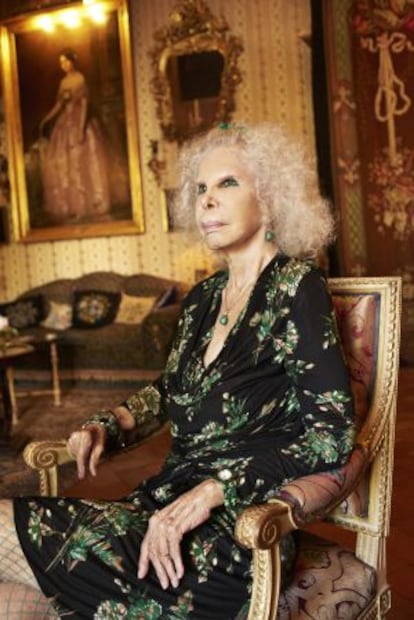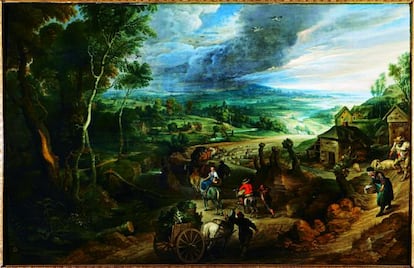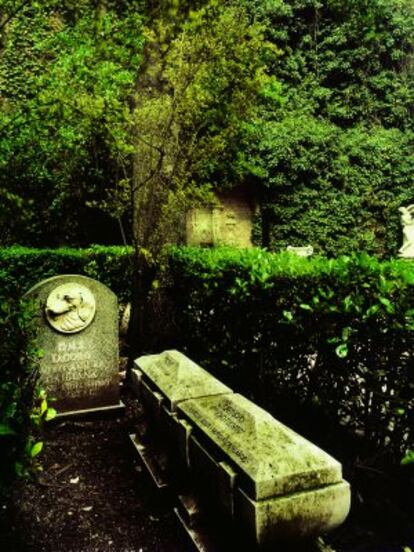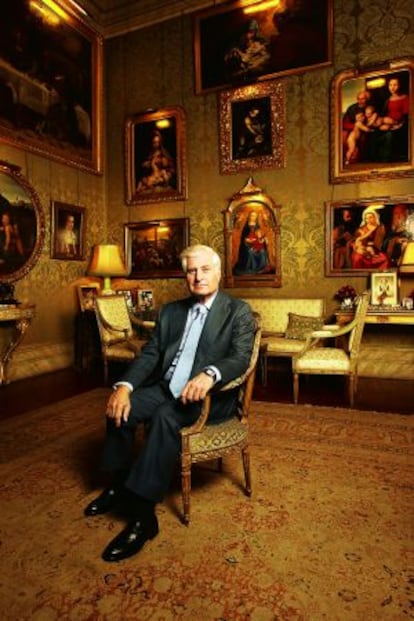A peek at the Duchess of Alba’s treasure
A new exhibition in Madrid will provide the most comprehensive review ever of the legacy of a dynasty that stretches all the way back to the 14th century

It was raining cats and dogs as we stood outside the gates of Liria Palace, an island in the heart of downtown Madrid where time stands still. Fortunately Luis, the uniformed butler, came to the rescue with an extra-large umbrella that was more than enough for the two of us. Walking down the stone path was like crossing through the looking glass. Reality was left behind as the large doors swung shut to reveal a disconcerting fantasy world within: the world of the House of Alba, a lineage with a history stretching back over 500 years.
The darkness of the storm did not help dispel the gloomy atmosphere inside. But as Manuel Vicent wrote in his brilliant portrait of Jesús Aguirre - second husband to the Duchess of Alba - the hardest thing at Liria Palace is finding the light switches. Every so often someone would walk by; it was one of the organizers of the exhibition of family treasures that will go on display at City Hall from November 30 to March 31.
Standing at the door and looking a little concerned about the downpour was Carlos Stuart, Duke of Huéscar and the eldest of the duchess's six children. He offered us water and coffee and ushered us into an office in the entrance area. It was a tidy, Victorian-looking room with mahogany bookshelves and shiny lamps that his parents bought in London in the 1950s. There were magnifying glasses, folders and pieces of paper on the desk, but no trace of a computer.
"I'm clumsy at this," he said jokingly. "Although I'm good with Google and I'm going to buy myself a tablet."

The words "Google" and "tablet" suddenly brought us back to the globalized world, and to some degree also to the world of evictions, street protests and budget cuts that we left outside the gates. At this point, the Duke of Huéscar reveals that he does in fact have a more modern workspace elsewhere on the premises: "I have a sitting room with a computer, but it is a more private kind of room."
It was then that we became aware of the perpetual time tunnel inside this house. Its inhabitants are constantly moving between the past and the present: Carlos Stuart, who has lived here since childhood, just like his siblings, grew up trying to find a sense of normalcy in what is simultaneously a regular home and a museum - not to mention the garden, which has a generous plot set aside for the graves of the dogs who came and went, whose gravestones bear tender epitaphs such as: "Willy, faithful dog of Liria, who came from Holland," or "Cartucho, tucho, tuchito, the dog of Jesús, who died at age 16."
And that is what Liria Palace really is: a museum with imposing balustrades, but one that bears the emotional seal of the family that lives in it. The art show's curator, Pablo Melendo Beltrán, was happy to show us around a place filled with valuable paintings by El Greco, Zurbarán, Goya, Ribera, Titian, Marc Chagall, Rubens and Rembrandt, distributed around the Flemish room, the Italian room, the Goya room, and so on. There is also a top-of-the-line library that draws historians who are interested in first editions of Cervantes' Don Quixote, or the original navigation charts that Christopher Columbus used on his journey to the Americas.
All these precious items and a whole lot more are coming out of the palace to go on public display in the coming weeks. It is the most comprehensive review ever of the legacy of a dynasty stretching back to the 14th century, when King Henry II of Castille awarded a dukeship to the Álvarez de Toledo family, originally from Alba de Tormes. The current lineage, however, began later, when the Fitz-James Stuarts, Dukes of Berwick, joined the Albas through marriage in the 19th century.

Now, the Albas want to open up to society, but doing so is a little more complicated for them than for the average family. "You will make us look good, won't you...," pleaded the Duke of Huéscar during the visit. Why should they come out looking bad, one wonders, when they are putting their private art collection at the disposal of all citizens? It is up to historians to judge them for their role in history. But it is also true that in today's media-ruled world, the demand for exclusives by gossip magazines and television programs provides the Albas with a postmodern dose of public glory and disgrace. Family arguments, the duchess's adventures and some of her children's antics regularly provide fodder for the media. But for now, the focus is on El legado de la casa de Alba (or, The legacy of the House of Alba), an exhibition with one overriding idea: patronage at the service of art.
The problem is that Cayetana Fitz-James Stuart, the 86-year-old Duchess of Alba (besides some 40 other titles of nobility, according to the Guinness World Records book) is the only person who is truly familiar with every last item inside her house, yet she was not available for comment on the day of our visit. It would seem as though her relatives were deliberately keeping the famously frank duchess away to preserve their carefully designed image, and it is hard to get any of the other members to talk about anything other than Spain and their loyalty to the king. Questions regarding their assets - three companies that run the 34,000 hectares of land they own across Spain - are not welcome. "We have three companies... But this interview is to talk about the exhibition," Carlos Stuart warned. What about employees at Liria Palace? "There must be about 25."
"It [the artwork] looks a lot better in an exhibition than it does here, where it's all piled up," added the Duke of Huéscar, who was keen to highlight the role of aristocracy in today's society, as well as his own family's constant efforts to preserve their artistic heritage as well as possible.
"Our duty is to focus on the management of the past and to maintain it in the best possible conditions before passing it on," he asserted. As for the role of aristocracy - or at least of the House of Alba - the task ahead is clear: "There are three characteristics: lead by example, serve your country and serve the crown."
The inhabitants of this house constantly move between the past and the present
According to the duke, these aristocratic duties are still observable today, even if the makeup of modern Spain means his social class is "diluted into society." Diluted perhaps, but providing a service nonetheless: "There are nobles in the army, in politics, in diplomacy, in the liberal professions..."
Besides fulfilling this role, aristocrats have also been maintaining an impeccable genealogy as a result of "an excellent marriage policy," according to José Manuel Calderón, the exhibition's historical advisor and a professor at Alcalá de Henares University.
The first Alba to start collecting art, according to Carlos Stuart, was the Marquis of Carpio, who gave the family 32 paintings that he either purchased or commissioned in the 17th century. This patron of the arts once owned Velázquez's Rokeby Venus, now kept at the National Gallery in London. "But it was Carlos Miguel, the 14th Duke of Alba, who really got everything started," said Carlos Stuart. "He was a friend of Rossini in the early 19th century, and a great music lover who bought nearly everything; and then there was my grandfather Don Jacobo and my mother..."
It was the latter pair who spearheaded the titanic efforts to rebuild Liria Palace after it was razed by the air raids on the Conde Duque barracks during the Civil War (1936-1939). The building went up in flames and many library books were lost, although most of the paintings were evacuated from the city together with artwork from the Prado Museum as part of an epic exodus toward the Pyrenees. The paintings, however, suffered greatly. Years later, Jesús Aguirre, Cayetana's second husband, insisted on restoring the collection and turned for help to Rafael Alonso, a curator at the Prado who has personally cared for the Albas' legendary paintings since 1978.

"The collection is in your hands," Aguirre told him one day, trusting him so much that he refused to let other people help him. The duchess's husband even built a workshop to ensure that Alonso could work inside the palace with no limitations of time or means. It is there that the curator, displaying the patience of a saint, still restores the artworks: "Each one requires its own treatment," he says. Now, Alonso has become one of the main pillars of the Alba exhibition because of the very healthy state that the paintings are in.
Rebuilding the palace was a whole other story. It was a young Cayetana who picked up where her father left off after his death in 1953. This was a woman unlike any other. A free spirit, she refused to pose for Picasso but did so for Zuloaga, who immortalized her as a child riding a pony. Cayetana de Alba always displayed a strong personality and continues to do so at age 86, having apparently decided to have nothing to do with the promotional work for this show - even though the crowds will come to the exhibition attracted by her star status and natural eccentricity. Yet after some insistence, the duchess agreed to pose for some photographs at her Seville home - the Dueñas Palace - and to answer some questions via email.
Her replies to the questions followed a careful script - in stark contrast with the personal meeting with the duchess that came later, in Seville. It is as though the members of the House of Alba were afraid to let her speak, especially now that everything and everyone, even the Spanish royals, are vulnerable to public judgment like never before, thanks to the global nature of social networks such as Twitter and Facebook.
Down in Dueñas, however, things seemed more relaxed. Cayetana's current spouse, Alfonso Díez, is a very proper, courteous man who ensured that everything went well for the duchess during the photo shoot. "I have very little time," she warned in the semi-darkness of the room where we were brought before her. Yet as she warmed up to her subject, Cayetana began to relax and expand on the short replies she had sent us via email.
I am a royalist through and through, and very proud to be so"
"We would like you to talk a little more about your vision of women in your dynasty. They all had character. Which one of them do you resemble?"
"They were all different. What little I remember about my mother is that she was very beautiful and very tender, and a great sportswoman. Same for my grandmother. The empress Eugenia de Montijo - wife of Napoleon III - had a strong character, a strong personality, she dressed marvelously well and she adored Spain and France. Cayetana, the one that Goya painted, was very personal; she did things the way she felt and acted as she pleased. But I am unlike any of them, no matter what people say.
"Reconstructing Liria Palace was a lifelong project of yours."
"My father told me that he would start on it if I took care of the rest. I said yes, and all the work was left up to me. But I don't back down on things that are worth it."
"And out of all the things that will go on display, is there something that is especially dear to you?"
"Odds and ends, souvenirs that I have been receiving all my life. But perhaps La Virgen de la granada, by Fra Angelico, is the one I like the most."
"We are clear about nobility's service to the Crown, but besides that, what should the role of aristocracy be in today's society?"
"I am a royalist through and through, and very proud to be so. I was baptized at the Royal Palace and my godparents were the king and queen. Monarchy is the best method of government in Spain, because this is a very difficult country, it is not easy. Spain's only glory is its monarchy. It unites a lot more and it prevents boxing matches and factions that throw everything overboard. The blame for what is happening in Spain today goes to..."
At this point Don Alfonso's voice quickly breaks into the conversation: "All right, Cayetana, it's over."
But the duchess insists: "The blame lies with that man that everyone knows about, but who is in hiding right now..."
Alfonso cuts in again: "Everyone makes mistakes, inside and outside Spain."
"I disagree," Cayetana retorts.
"There you have it, she's so natural, you come here and she treats you like old friends, and I tell her, 'Cayetana, these are not friends... these are journalists'," says her husband.
At that point, we bade them farewell and went on our way - with a photograph, an interview and a suspenseful finale that we will let our readers decipher for themselves.
English version by Susana Urra.
Tu suscripción se está usando en otro dispositivo
¿Quieres añadir otro usuario a tu suscripción?
Si continúas leyendo en este dispositivo, no se podrá leer en el otro.
FlechaTu suscripción se está usando en otro dispositivo y solo puedes acceder a EL PAÍS desde un dispositivo a la vez.
Si quieres compartir tu cuenta, cambia tu suscripción a la modalidad Premium, así podrás añadir otro usuario. Cada uno accederá con su propia cuenta de email, lo que os permitirá personalizar vuestra experiencia en EL PAÍS.
¿Tienes una suscripción de empresa? Accede aquí para contratar más cuentas.
En el caso de no saber quién está usando tu cuenta, te recomendamos cambiar tu contraseña aquí.
Si decides continuar compartiendo tu cuenta, este mensaje se mostrará en tu dispositivo y en el de la otra persona que está usando tu cuenta de forma indefinida, afectando a tu experiencia de lectura. Puedes consultar aquí los términos y condiciones de la suscripción digital.
Archived In
Últimas noticias
The complicated life of Francesca Albanese: A rising figure in Italy but barred from every bank by Trump’s sanctions
How Japan is trying to avert ‘digital defeat’
Half of Scotland is in the hands of 420 property owners
Reinhard Genzel, Nobel laureate in physics: ‘One-minute videos will never give you the truth’
Most viewed
- Pablo Escobar’s hippos: A serious environmental problem, 40 years on
- Why we lost the habit of sleeping in two segments and how that changed our sense of time
- Charles Dubouloz, mountaineering star, retires at 36 with a farewell tour inspired by Walter Bonatti
- Reinhard Genzel, Nobel laureate in physics: ‘One-minute videos will never give you the truth’
- The Florida Keys tourist paradise is besieged by immigration agents: ‘We’ve never seen anything like this’









































